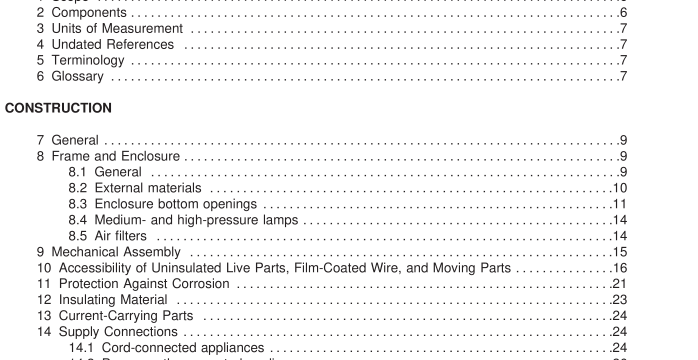UL 22-2008 pdf download.Amusement and Gaming Machines.
6.1 0 MAINTENANCE KEY – Key or other means which provides access to the maintenance area but does not permit access to the service area. 6.1 1 MAINTENANCE PERSON – The person who performs routine maintenance such as the setting of controls and other minor adjustments. Some examples of maintenance are: a) Replacement of lamps and fuses and resetting of circuit breakers located in a user-access area unless the lamps, fuses, or circuit breakers are marked to indicate replacement or resetting only by service personnel. b) The making of routine operating adjustments including, but not limited to, cleaning the machine, clearing the coin mechanism of jams, removing coins or price changing. 6.1 2 NEON TUBE – A small diameter glass cylinder, evacuated of air and filled with an inert gas such as neon, which emits light when excited by a high voltage neon transformer or power supply. 6.1 3 OUTDOOR LOCATION – An area that is open and subjected to the full effects of weathering. 6.1 4 PRIMARY CIRCUIT – Wiring and components that are conductively connected to a branch circuit. 6.1 5 PROTECTED LOCATION – An area that is partially protected from the effects of weathering through the use of a roof, canopy, marquee, or the like. 6.1 6 SAFETY CIRCUIT – Any primary or secondary circuit that is relied upon to reduce the risk of fire, electric shock, high current levels of electrical energy, or injury to persons. For example, in some applications, an interlock circuit is considered to be a safety circuit. 6.1 7 SECONDARY CIRCUIT – A circuit supplied from a secondary winding of an isolating transformer. 6.1 8 SERVICE AREA – An area where access cannot be gained by the use of a maintenance key alone.
7 General 7.1 Only materials that are intended for the particular use shall be used in amusement and gaming machines. 7.2 When the deterioration or breakage of any part that contains, conducts, or otherwise contacts a liquid could result in a risk of fire, electric shock, or injury to persons, the part shall be of a material resistant to corrosion by the liquid to be used therein and shall have the strength to withstand the pressures involved. 8 Frame and Enclosure 8.1 General 8.1 .1 An enclosure, guard, or barrier shall have the strength and rigidity to resist the abuses likely to be encountered during intended use of the appliance without increasing the risk of fire, electric shock, or injury to persons due to total or partial collapse with resulting reduction of spacings to less than required, or the loosening, displacement, or exposure of parts, or other serious defects. 8.1 .2 An enclosure, guard, or barrier of an appliance shall be complete, or completion of the enclosure, guard, or barrier shall be attained when an appliance is installed for operation. 8.1 .3 A required enclosure, guard, or barrier shall be capable of being removed and replaced with a minimum of effort when removal is necessary to service the protected parts. 8.1 .4 The strength and rigidity is to be evaluated by the tests in: a) 45.2.1 – 45.2.3 and 45.4.1 for a nonmetallic enclosure or guard; b) 45.3.1 – 45.4.1 for a metal enclosure or guard; and c) 45.4.1 for a barrier that is accessible to a maintenance person. The enclosures, guards, and barriers of an appliance intended for outdoor use shall be tested for resistance to the atmospheric effects of rain and sunlight.
8.2.4 The flame-spread index in 8.2.3(b) is the average value based on tests on six specimens representative of the wall thickness used, with no single specimen value greater than 300. 8.2.5 A material with a flame-spread index higher than specified in 8.2.3 may be used as the exterior finish or covering on any portion of the enclosure, guard, or cabinet if the flame-spread index of the combination of the base material and finish or covering complies with 8.2.3. 8.2.6 The size limitations mentioned in 8.2.3 refer to the exposed surface area of a single unbroken section. If two sides of a single piece are exposed, only the larger side is to be considered in computing the area. 8.2.7 A conductive coating applied to a surface (such as the inside surface of a cover or an enclosure) shall comply with the appropriate requirements in the Standard for Polymeric Materials – Use in Electrical Equipment Evaluations, UL 746C. Exception: When flaking or peeling of the coating will not result in the reduction of spacings or the bridging of live parts that may present a risk of fire or electric shock, then the coating need not comply with UL 746C.UL 22-2008 pdf download.
UL 22-2008 pdf download
